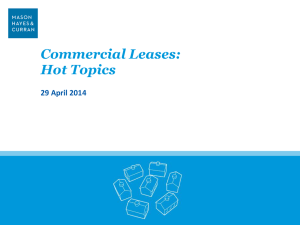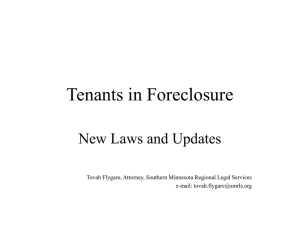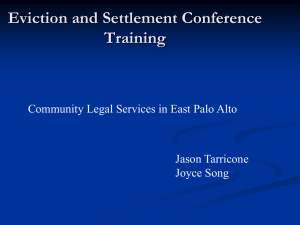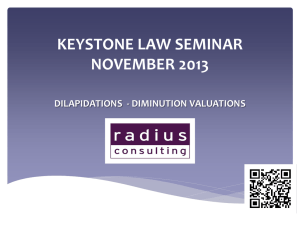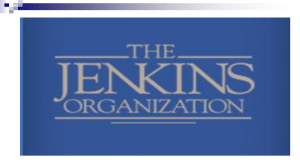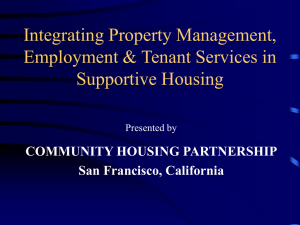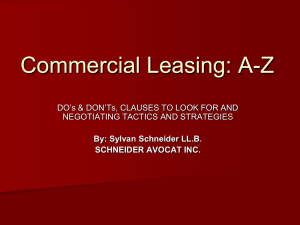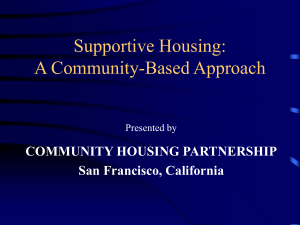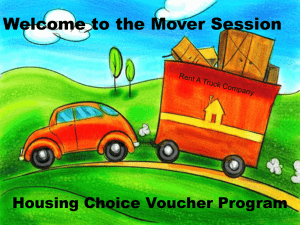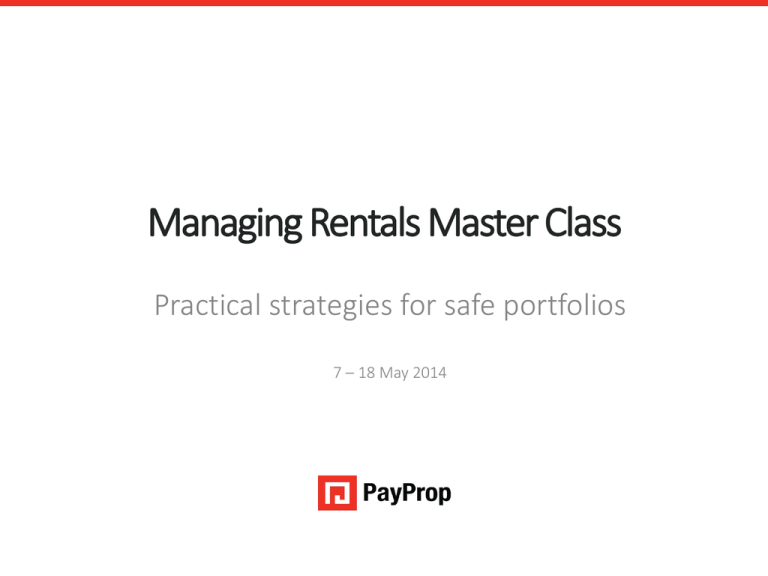
Managing Rentals Master Class
Underwritten by RMB Structured Insurance Limited
Practical strategies for safe portfolios
7 – 18 May 2014
An authorised financial services provider – FSP 43441
First, a note on CPD points
• 60 points need to be earned in a 3-year cycle (20 points per year)
• Points are split into 2 categories, namely verified and non-verified
• Currently the EAAB is the only body allowed to provide verified training
• Non-verified training has to conform to time and content requirements (duration & relevancy)
3-year Cycle
(60 points)
Verified
Non-verified
(45 points)
(25 points)
Education and training
Professional development (max 5)
Corporate social investment (max 5)
Mentoring and coaching (max 5)
Reading and publishing (max 5)
Personal development (max 5)
And then a word on who we are
Our agenda for this morning
An authorised financial services provider – FSP 43441
The State of the Rental Industry
Q1 2014
An authorised financial services provider – FSP 43441
Average rentals touch on R6 000
• Current weighted average rental in South Africa is R5 934
Growth starting to slow down
• Growth rates are slowing down after hitting a high of 10.8% in October 2013
• Current year-on-year growth rate is 8.4%
Stock shortages driving increases
• A lack of stock formation over the past decade has created shortages
• Stock shortages are driving increases, not improvements in the underlying economy
Limpopo normalising
• Limpopo is starting to slow down
• Mpumalanga continues its stable growth
• Eastern Cape stages an impressive recovery
• Northern Cape is the new emerging star
• Free State continues to struggle
• Western Cape, KZN and Gauteng continue to
experience stable growth
• Very little movement in the North West
Damage deposit ratios reach their limit
• Stabilisation in damage deposit ratio
• Currently at 1.29 times the average rental value (down from a high of 1.33 times)
• It seems that there is a limit to what tenants can afford
• Growth of deposit replacement products
Low but stable investor returns
• Both net and gross yields remain stable – despite rental growth
• Increase in property values neutralises gross yield gains
• Increase in cost of ownership neutralises net yield gains
• Remember that the yield calculation does not take capital growth into account – if that is added
in, it increases to 12.81%
• Rental yields therefore only cover the cost of ownership and investment opportunity costs
‘Counter-intuitive’ provinces lead the pack
• Northern Cape, Limpopo and Mpumalanga offer the best returns for investors
• High cost of ownership in the Western Cape and Gauteng limit what investors are able to take
home
Location, location, location…
• Free State cost of ownership is high because of the ratio of fixed costs relative to extremely low
rentals
• High unit costs in Gauteng and Western Cape are driving up this number in these areas
• In Limpopo, Northern Cape and Mpumalanga lower costs of ownerships are reflected in the
higher yield numbers
Agents defend their commissions
• Agents seem to have taken a deliberate decision to defend their commissions
• There was a time that the data showed a declining trend, similar to that of sales commissions
• We would urge agents to protect this number at all costs
Our predictions for the remainder of 2014
1. Average rental growth will settle in the 8% - 10% range
2. Consumer payment data will continue to deteriorate
3. Damage deposits will become unaffordable to tenants and deposit replacement products will
become more commonplace
4. Property investors will not see net yields of above 6% for some time
5. Watch the Northern Cape!
Preparing leases and mandates
An authorised financial services provider – FSP 43441
Leases and mandates
Lease agreements and mandates can be divided into three categories.
A) Invariable provisions
The obligations which the law requires to be part of the contract whether the parties wish to have
them or not –
•
The Rental Housing Act (RHA),
•
Unfair Practice Regulations,
•
Consumer Protection Act (CPA),
•
Estate Agency Affairs Act (EAAA)
•
Code of Conduct
B) Residual provisions
The common law obligations which apply in the absence of any agreement to the contrary. Case law
and commentary.
C) Agreed provisions
Those which the parties agreed to themselves as long as they are lawful
The written agreement
•
For an agreement to be concluded, all parties should be clear with regard to its terms.
•
In the instance of a lease, issues such as the rental payable and the duration of the lease should be
addressed and agreed upon.
•
In the instance of a mandate, issues such as the commission payable, duties – i.e. to procure or
manage and duration of the mandate should be addressed and agreed upon.
•
There is a risk of uncertainty between the parties on these essential terms in the absence of a
written agreement.
•
Moreover, each party may hold a differing view as to what they agreed upon at the outset and
proving who is correct becomes difficult without a written agreement.
•
The burden of proof typically rests on the party alleging an agreement contains a specific term and
he may be hard-pressed to render satisfactory proof of the problematic provision.
•
Therefore a written agreement provides both parties with greater peace of mind due to the clarity
established with regard to their rights and obligations and to their continued relationship.
The lease
The Rental Housing Act (RHA) requires the landlord to reduce the lease agreement to writing if the
tenant so demands, making it a legal requirement in the case of residential leases. (s 5 (2) RHA)
The Consumer Protection Act (CPA) provides that:
• The producer of a notice or document …. that is required, in terms of this Act or any other
law,…….. must produce, provide or display that notice or document….
• a) in the form prescribed in terms of this Act or any other legislation, if any, for that notice,
document ………; or
• b) in plain language, (s 22 (1) CPA)
•
A properly drafted lease will provide that the Landlord can cancel the lease if the rent is late. It
should state that where there has been any other breach of the lease terms, the landlord has a right
to terminate the lease.
•
Restricting usage of the premises: The only way to restrict what the tenant does in the property is to
have limitations in a written lease on what the tenant can and cannot do. This can prevent the
tenant doing something which may be a nuisance, and could depress rental values on other
properties or stigmatise the property they are occupying.
The mandate
• Mandates could be written, oral or tacit
• It provides that the agent must fulfill the terms of the mandate, after which the agent is entitled
to his commission
Marketing only:
-The agent is only responsible for finding a tenant, nothing further, and is not responsible for the
ongoing management of the property.
Management:
-The agent will take care of virtually everything (apart from what the owner excludes).
Remuneration is usually higher than in the case where the estate agent only markets the property
The mandate
Ensure there is a clear, written contract detailing exactly what services the agent will provide in return for
his management.
• Commission fees: How much?
• Management fees: Is it a set amount or a percentage of the rent?
• Renewal fees: What charges does the owner incur when the tenant wishes to renew the lease?
• Deposit details: Who holds the deposit? Can the agent hand over the keys to the premises before
the deposit and first months’ rental is received?
• Payment of rental: How long after the agent receives the rental will it be paid over to the
landlord?
• Repairs and emergencies: How much can the agent spend without the owner’s consent?
• Marketing of the property: Will it be done via newspaper, internet, signs in front of property, etc?
• Rent arrears: What steps will the agent take to ensure arrear rentals are paid?
The CPA
An authorised financial services provider – FSP 43441
The CPA in general
• It applies to the mandate between a rental agent and landlord (where the landlord (the
consumer)is a natural person or a juristic entity below the threshold of R2 million)
• It applies to the lease agreement between a landlord and tenant (where the tenant(the
consumer) is a natural person or a juristic entity below the Threshold of R2 million )
• The maximum length of the mandate or lease agreement is 24 months, unless a longer period
is expressly agreed and the supplier can show a demonstrable financial benefit to the
consumer.
• A tenant may cancel the lease agreement; or a Landlord may cancel the mandate at the expiry
of the fixed term without any penalty.
The CPA in general
A tenant may cancel the lease agreement; or a landlord may cancel the mandate at any time during
the fixed term by giving 20 business days’ notice, however a reasonable cancellation penalty may be
charged taking into account the following in terms of section 5 of the Final Regulations:
•
•
•
•
•
•
amount the consumer is still liable for up to date of cancellation;
value of transaction up to cancellation;
duration of initial agreement;
losses suffered or benefits accrued to the consumer;
length of notice of cancellation provided by the consumer;
reasonable potential for the service provider, acting diligently, to find an alternative
consumer;
• general practice of the relevant industry.
Sections 11 -13 allow for a 5-day cancellation by the tenant if the contract is the result of direct
marketing
Section 2(9) of the CPA
If there is an inconsistency between any provision of this Act and a provision of any Act not
contemplated in subsection (8)-
• the provisions of both Acts apply concurrently, to the extent that it is possible to apply and comply
with one of the inconsistent provisions without contravening the second; and
• to the extent that paragraph (a) cannot apply, the provision that extends the greater protection to
a consumer prevails over the alternative provision.
• In short, the CPA will, inevitably, trump the RHA and EAAA
Section 14 CPA for landlords
The landlord (or his rental agent) or must contact the Tenant between 40 and 80 business days
before the expiry of the lease:
•
to notify the tenant in writing that the lease is about to expire and should the tenant wish to
renew what any material changes would apply – for example the increased rent.
•
The tenant may then choose not to renew and must vacate the property on the expiry date.
•
The tenant may choose to renew and enter into another fixed-term lease at the agreed new
terms and conditions.
•
The tenant may choose not to respond to the notice, in which case the lease continues on a
month-to-month basis as per the material changes in the notice to the tenant. The tenant is then
responsible to provide the landlord (or his rental agent) with a calendar months’ notice.
Section 14 CPA for rental agents
The rental agent must contact the landlord between 40 and 80 business days before the expiry of the
mandate:
•
to notify the landlord in writing that the mandate is about to expire and should the landlord wish
to renew what any material changes would apply – for example the increased commission.
•
The landlord may then choose not to renew the mandate on the expiry date.
•
The landlord may choose to renew and enter into another fixed term mandate at the agreed new
terms and conditions.
•
The landlord may choose not to respond to the notice, in which case the mandate continues on a
month-to-month basis as per the material changes in the notice to the landlord. The landlord is
then responsible to provide the rental agent with a calendar month’s notice.
Deposits
An authorised financial services provider – FSP 43441
Deposits
• Tenant usually pays a security/damages deposit to the landlord at the beginning of the rental term.
• In most cases, the deposit is used as security for repair or damage to the rental unit occurring during
the tenancy, and/or the return of the property.
The Rental Housing Act (s5)
• Requires the deposit be invested in an interest-bearing account with a financial institution which
interest must be paid to the tenant
• Where the landlord is a registered estate agent the deposit and any interest thereon shall be
dealt with in accordance with the provisions of the Estate Agency Affairs Act
• The deposit may be used to pay all amounts for which the tenant is liable under the lease,
including the reasonable cost of repairing damage to the dwelling during the lease and the cost
of replacing lost keys
• The tenant may not be held liable for “fair wear and tear”
• Ingoing and outgoing Inspections MUST be held, failing which the landlord must refund the entire
deposit – RHT are adamant about this.
• The landlord must provide receipts and factual proof of expenditure before making deductions
Can the landlord increase the security deposit
after the tenant moves in?
• This is dependent on the terms of the lease agreement.
• The security deposit cannot be increased during the term of the lease, unless allowed by the lease.
• In the case of a periodic lease agreement (month-to-month lease), the landlord can increase the
security deposit on one month’s notice.
However, allowing the landlord to unilaterally determine the amount of the increase may be unlawful:
• It may constitute oppressive conduct for purposes of the Rental Housing Act
• It may also constitute an unfair, unreasonable or unjust term for purposes of the Consumer
Protection Act
It is advisable that the lease agreement state the percentage by which the deposit will increase and when
How large can a deposit be?
• Neither the amount of the deposit nor the type of cover a landlord can accept instead of a
deposit is regulated by either the Rental Housing Act or the Consumer Protection Act.
• The only restriction is that contained in the Rental Housing Act, stating that it “may not exceed
an amount equivalent to an amount specified in the agreement or otherwise agreed to
between the parties …” (s5(1)(c) RHA
• It follows that the parties are free to agree on the amount of the deposit and a deposit
replacement guarantee.
For what can the security deposit be used?
There are essentially four (4) things which the landlord may use the security deposit
1. For unpaid rent
2. For cleaning the rental unit when the tenant moves out, if the unit is not as clean as
when it was rented
3. For repairs if necessitated by the tenant or the tenant's guests (but not for ordinary
wear and tear and damages which existed before the tenant moved in)
4. The cost of restoring or replacing personal property (including keys), furniture, or
furnishings (excluding ordinary wear and tear)
A landlord can withhold only those amounts that are reasonably necessary for these
purposes.
For what can’t the security deposit be used?
•
For repairing or replacing items damaged only by normal wear and tear
•
For repairing defects that existed in the unit before the tenant moved in
•
For cleaning a rental unit that is reasonably clean
When must a security deposit be refunded?
• If an outgoing inspection is held, not later than 14 days after restoration of the dwelling to the
landlord
• If the tenant does not appear at the outgoing inspection, not later than 21 days after expiration
of the lease
Understanding tenant risk
An authorised financial services provider – FSP 43441
Tenant risk guide
We will cover the following points:
•
What are the risks and how can they be mitigated?
•
Explain the importance of tenant assessment and some tools
•
What to look out for - contracting party vs. the tenant – identity fraud
•
The purpose of using credit history in evaluating tenant risk
•
The requirement for consent - the relevance of the POPI Act
•
Knowing who to use credit reports – the basics
•
What can be buried in the detail - number of accounts, recent checks
•
How are these reports are compiled - credit bureaux and the CPA
•
Why tenants can be declined - case study: DepositGuarantee rules
Tenant risk: summary overview
A definition of risk:
“The probability or threat of quantifiable damage, injury, liability, loss, or any other
negative occurrence that is caused by external or internal vulnerabilities, and that may be
avoided through preemptive action.”
•
Quantifiable damage – the usual suspects: property, possessions, cashflow
•
The lesser-known, greater threat – opportunity cost
•
What can go wrong…the tenant:
– doesn’t/can’t pay rent
– will not vacate the property
– damages the property
– thinks the damage deposit is for the last month’s rental…
•
Corrective action: legal, contractual remedies and processes
•
Preemptive action: tenant assessment tools
Tenant assessment tools
You are your landlord’s appointed risk manager
•
Preemptive action: tenant assessment tools
– Identity verification checks:
Who is this person? Are they who they say they are?
– Reference checks:
What relationships do they keep? Work, family, friends
– Credit checks:
What has their financial behaviour been like over time?
– Tenancy checks:
What is their track record in rent, care of property etc?
– Affordability checks:
Can they meet their financial commitments into the future?
What to look out for…
Identification verification checks:
•
Does the ID number match the name of the tenant on the credit check
•
Do you have a full set of 3rd party contact details for the tenant
Credit checks: (historical view)
•
Check more than just the credit history
•
Recency: When was the last time they applied for credit?
•
Frequency: How often have they applied in the last three months?
Affordability checks: (future view)
•
Can the tenant fulfill their current credit commitments?
•
Compare amount of credit authorised vs. curent credit available
Tenancy checks: (behavioural view)
•
Did the tenant pay on time, in full & completed lease, liability free?
Amnesty Act?
National Credit Amendment Bill:
The credit ‘amnesty’ is not an amnesty as commonly understood — a chance for errant debtors to
have the slate wiped clean. Rather, it entails changes in the type of information that is kept on
debtors, and puts the onus on credit bureaus to clean up the records of those who have repaid
their debts:
•
Credit bureaus had until April 30 to remove from the records of those who have repaid their
debts any adverse classification of consumer behaviour and adverse classification of
enforcement action.
•
Terms that must be removed include "slow paying", "delinquent", "defaulter", "absconded" or
"not contactable".
•
Under the amended act, credit bureaus must automatically remove this information as soon as
a debtor repays a debt.
•
Factual and detailed payment profiles will be retained for a period of five years, enabling credit
providers to obtain a detailed history of a potential debtor’s payment behaviour
(Partick Bracher, 2014: Norton Rose)
Importance of consent
Protection of Personal Information Act (POPI):
•
Covers information relating to clients, suppliers, employees, persons receiving marketing information,
persons present on premises etc.
•
All personal information which is protected incl.: race, gender, sex, marital status, sexual orientation,
age, physical/mental health, religion, criminal and financial records.
•
Sources of information impacted include payroll data, CVs, employment applications, HR & security
records, standard information, even internal emails.
•
Existing manuals created in terms of the Promotion of Access to Information Act which spell out the
company’s policy must be updated in line with PoPI.
•
Explicit permission needs to be given for collection and use before data is collected.
•
Data can only be collected from public domain; no more rented database lists
•
Companies will also need to motivate why they need to keep certain data.
•
Individuals need to be informed for how long information will be kept.
(Institute of Directors SA, 2014)
Where does the information come from?
Credit & tenancy checks:
•
TransUnion ITC & Experian
– US headquarters & UK headquarters respectively
•
Compuscan
– SA headquarters – grew out of serving the microfinance industry
– PayProp Capital partner
•
TPN
– Currently the sole source of tenancy data in South Africa
•
Credit Providers Association
– Group of SA retailers, banks, insurers, other service providers
– Share data on client payment history, stored by credit bureaus
– PayProp Capital is a registered CPA member
Case Study: PayProp DepositGuarantee
Underwritten by RMB Structured Insurance:
•
Cover = 2,5 x monthly rental amount up to R50,000 maximum
•
1 x month loss of rental - remainder damages, utility, legal costs
Eligibility process:
•
Credit history: No. of accounts & payment discipline
•
Affordability: future view in terms of indemnified risk
•
Adverse conditions: judgements, defaults, traces
Experience to date:
•
55% of Applicants Ineligible
•
Mostly credit & adverse history: serious financial distress
•
Cross check of different reports & data sources recommended
Tools for the journey
INASSOCIATION WITH
PAYPROP DEPOSITGUARANTEE
SUGGESTED TENANT AGREEMENT CLAUSE
OFFICE 087 820 7260 | FAX 086 615 0176 | support@paypropcapital.com | www.paypropcapital.com
PRACTICE NOTE:
The issue of a deposit is regulated by both the Rental Housing Act – Section 5(3) (d) and the Estate Agency Affairs Act –
Section 32.
The deposit provides security for a landlord in the event of damages or arrear rental being owed upon the expir y of the lease.
Deposits, however, are but one option the landlord has. To cater for another option, please find below a draft clause for
insertion into your lease agreement.
It’s very important that you look carefully at the wording of your lease because the this clause may need to be adjusted to fit
in with the lease, so that the option of the “Deposit Replacement Agreement” will not only be in place, but also provide the
protection the landlord and tenant need.
The clause below is in italics and is also repeated in the Deposit clause below to give
you some guidance:
“ Notwithstanding anything else contained her ein, the landlord may (in his/her/its sole discretion) accept a written
guarantee (in a form acceptable to him/her/it) instead of payment of the deposit (or part ther eof) as contemplated/
provided for herein (above).”
This clause simply means that, irrespective of what else the lease might say about deposits, the landlord has the right to accept
a written guarantee, such as the “Deposit Replacement Agreement”, instead of a cash deposit, or a portion of the cash deposit.
Please remember that if you are using another word to describe the landlord in your lease agreement, such as lessor, owner
etc, please change the word “landlord” in your deposit replacement agreement accordingly in the clause, to avoid ambiguity.
Version number 1 – April 2014
PayProp Capital (Pty) Ltd, an authorised financial services provider – FSP 43441
Underwritten by RMB Structured Insurance Limited – FSP 1027
1
Reconciling trust accounts
An authorised financial services provider – FSP 43441
What are my legal responsibilities?
29. Duty of estate agent to keep accounting records
1) Every estate agent shall in respect of his activities as such a) keep in one of the official languages at an address in the Republic such
accounting records as are necessary fairly to reflect and explain the state of
affairs i) of all moneys received or expended by him, including moneys
deposited to trust account referred to in section 32(1) or invested in a
savings or other interest-bearing account referred to in section 32(2)(a);
ii) of all his assets and liabilities; and
iii) of all his financial transactions and the financial position of his business;
b) cause the accounting records referred to in paragraph (a) to be audited by an
auditor within four months after the final date of the financial year of the
estate agent, which final date shall after the commencement of section 9 of
the Estate Agents Amendment Act, 1984, not be altered by him without the
prior written approval of the board.
32. Trust account of and investment of trust moneys by estate agent
3) Every estate agent shall a) keep separate accounting records of all moneys deposited by him in his trust
account and of all moneys invested by him in any savings or other interest bearing
account referred to in subsection (2)(a);
b) balance his books and records relating to any account referred to in paragraph
(a) at intervals of not more than one month, and cause them to be audited by
the auditor referred to in section 29(b), within four months after the final date
of the financial year of the estate agent concerned
1. The responsibility to audit both
the trust and business accounts is
not new and has been in the Act
since 1976
2. Both the section 32(1)
[transactional] and section 32(2)
[deposit accounts] accounts need
to be audited
3. If you open a separate 32(2)
account for each tenant’s deposit,
you need to declare EVERY ONE in
your audit submission to the EAAB
4. You need to reconcile all your trust
accounts every month – and you
need to be able to show that you
have done so
What is the prescribed format?
The EAAB prescribed six-page document needs to be submitted four months after the end of
your financial year
• In the report your auditor confirms that:
• all the sections on the previous slide have been complied with
• all the trust accounts of the business are explicitly listed
• any qualifications on the audit of both the business and trust accounts are mentioned
• you have a valid FFC
• you have a FIC registration number
• where you have paid interest to tenants that you had the contractual right to do so
• your trust account never went into the negative
• that they are a registered auditor and are appropriately licensed to audit trust accounts
• In signing the report the principals of the agency confirm that they:
• are fully in charge of how the financial system of the agency is run
• have put appropriate measures in place to ensure the proper financial administration of the
business and trust accounts
• are responsible for ensuring this report reaches the EAAB on time
Things to remember
• Things to remember
• If there is a qualification on your audit the issuing of your FFC will be delayed
• It is YOUR responsibility to ensure it his handed in on time – and to be able to prove it
• Just because your auditor completed and submitted it, it does not mean you are absolved of
responsibility of the content
What is a bank reconciliation?
• Essentially a comparison between the balance of your trust account and the result of your
accounting calculations
• Ensures that your records and the records of your financial institution are in agreement
• Enables you to determine if there were any errors made in receiving or disbursing funds and the
posting of transactions to your accounting records
• Is done by comparing the balance of your bank account, according to your bank statement, with
the balance of the account according to your accounting records
• It further identifies any causes of differences, including any corrections that you or the bank may
have had to make to correct the balances
• The results of this activity are recorded in a formal trust account reconciliation statement
Why are there reconciliation differences?
• Unidentified incoming payments that are never allocated in your accounting system
• Payments that reflect incorrect amounts (especially cash deposits)
• Debit order failures after payments have been made
• Internal accounting movements that happen outside of your banking system
• Not taking bank charges into account
• Timing differences between receipt and reflection
• Timing differences between reflection and recording
• Posting errors on your accounting system
• Malicious editing of ‘upload/download’ files if you use them
• Submission failures on ‘upload/download’ files if you use them
What documents do I need to do a reconciliation?
• Trust account bank statement
• Opening and closing balances
• Full detail of all incoming and outgoing transactions
• Trust journals with detailed accounting records for the same period
• Opening and closing balances
• All receipts
• All outgoing payments
• All debit/credit notes
• Client sub-ledgers
• Opening and closing balances by client
• All transactions pertaining to that client (incoming and outgoing)
• Supporting documentation for the above
How do I perform a trust account reconciliation?
• We could tell you, but showing is going to be much more fun…..
Practical exercise
1
2
3
4
5
6
7
8
9
10
11
The tenant's balance as of 28 Feb 2014 was -R5 000 as he was a month in arrears
There were no actual funds in the bank to pay even a small part of his arrears
The tenant was then invoiced R5 000 on 25 February for rental for the month of March and
R250 for repairs that he is liable for.
Both payments are due on 1 March 2014
The tenant paid his rent of R5 000 on 25 February 2014
The balance reflected on your bank account on 26 February 2014
Your clerk only recorded the transaction on 2 March 2014
You paid R250 to Johns Glass repair on 28 February already because the supplier needed the
money urgently
With permission from the tenant and landlord you moved R5 000 from the deposit account
(which is held in another bank) on 3 March to pay the month’s arrears to the landlord
You subtracted R1 000 in commission on 2 March for your services
On 5 May you settled with the landlord
What is the trust recon balance at the end of March?
What is the solution?
CLIENT BALANCE RECON
Opening Balance
Invoice 1
Invoice 2
TOTAL OUTSTANDING
•
R -5 000
R -5 000
R -250
R -10 250
Rental received
Deposit transfer received
TOTAL RECEIPTS
R 5 000
R 5 000
R 10 000
TENANT BALANCE
Invoice for new damage deposit
FINAL TENANT BALANCE
R -250
R -5 000
R -5 250
If your solution looked like this – you were reconciling the wrong thing
What is the solution?
The tenant paid in R5 000 in February and
you used R250 immediately
Take note that the tenant still owes R250 for
the repairs
Option 1 Option 2 Option 3
Opening Balance
R 4 750 R 4 750 R4 750
Incoming Funds
R 5 000 R 5 000 R5 000
Commission paid
R -1 000 R -1 000
-R750
Owner payments made R -9 000 R -8 750 -R9 000
BALANCE
R -250
R0
R0
Additional Considerations
•
•
•
•
What about bank fees?
What does the deposit account look like?
What should I have done if I went for Option 1?
If I covered the repairs from my commission, how
would I have treated the recovery?
You moved R5 000 from the deposit
account into the trust account
You took 10% commission on the R10
000 (an alternative solution would have
been to only take R750 and cover the
cost of the repairs yourself) for the time
being
Paying the owner R9 000 would have
been wrong, because it would have put
the trust account in deficit by R250
What did we learn?
• There is a difference between a trust account reconciliation and a client balance reconciliation
• You need to do both, but for different reasons
• The trust account recon deals purely with ‘real money’ and that is what the EAAB is
interested in
• The client balance recon deals with ‘theoretical balances’ and that is what your owners
are interested in
• Timing errors are easy to make
• You paid the R250 because you had the money in the account – but most forget to take
this into account in the next month
• If you paid the owner R4 500 x 2 you put the trust account in deficit – which is an audit
qualification
• There should be an audit qualification because you took commission before it was due to
you
• Did you remember to re-invoice the tenant for the deposit you used?
What if I am a PayProp client?
• PayProp does this reconciliation process for you every 24 hours
• PayProp is able to do this because it is the only trust account platform that integrates direct
banking straight into your trust account’s accounting
• PayProp trust account reconciliations are audited by external auditors (PWC) every 30 days
• At the end of your financial year, our auditors provide you with an Agreed Upon Procedures (AUP)
letter stating:
• trust account balances at the end of the period
• all interest that was paid out to tenants
• that the trust account has never gone into a deficit
• This is NOT an audit report, but merely provides the information that your auditor needs in order
to complete the audit
•
Using the AUP saves your auditor a significant amount of time (and saves you a significant
amount of money)
Tips for interpreting and reviewing reconciliations
• Carefully review the work of others
• You may choose to delegate the preparation of the monthly reconciliations and comparisons to a
staff member, your bookkeeper or accountant. You may delegate the work, but not the
responsibility
• Ensure you are given original copies of statements
• If you do not receive paper statements, be sure to access and print off your account information for
the reconciliation period personally, rather than rely on copies of statements provided by those who
prepared the reconciliation.
• It is your responsibility to ensure that there are sufficient funds in trust to meet all of your trust
obligations.
• Although someone else may prepare the reconciliation and comparison, any shortages or errors are
ultimately your responsibility, and you are required to make up for any shortages.
• Ask for explanations
• If you do not understand items on the reconciliation prepared by someone else, ask the person(s)
who prepared the reconciliation and comparison for clarification with supporting documentation.
Things to look for in a review
• Unexplained items that appear in order to balance your records. No amount is too small to
investigate—you must be able to account for every cent Frequent requests to cover shortages in
trust: Regardless of the amount, any request made of you to cover shortages should be explained in
detail and should be supported with documentation.
• Recurring bank or processing errors that are outstanding from month to month
• Overdrawn client sub-ledgers balances that reoccur from month to month: When you review your
trust list, you should question why any trust sub-ledger became overdrawn.
• Any reoccurrence of overdrawn sub-ledgers should be a concern to you, regardless of the amount.
• Trust account disbursements posted with blank payee names or with generic names like “client” or
“bank”: For all disbursements, you should see the actual name of the payee and the reason for the
payment in the journal entry.


